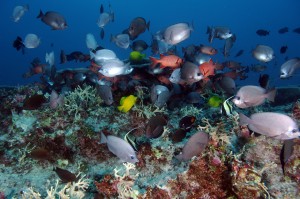Monitoring Coral Reefs using Quadrats

Originally appears in the Spring 2011 issue
Coral reefs are the “rainforests of the ocean”[1] and are home to an estimated one-quarter of the world’s marine species; however, their future is under serious threat. Roughly 70% of coral reefs worldwide have been threatened or destroyed, and an estimated 20% have been damaged beyond repair.[2] To understand why, we need to take a closer look at the anatomy of coral reefs.
Coral polyps have small algae, or zooxanthellae, growing inside them. In this symbiotic venture, the polyps provide shelter and nutrients for the zooxanthellae. In return, the algae produce food for the polyps through photosynthesis. Because they photosynthesize, the zooxanthellae need sunlight to live: this is why most corals grow in shallow water. If the zooxanthellae become stressed, for example due to high water temperatures, they may leave the polyps.[3] This exposes the white calcium carbonate skeletons of the corals, resulting in “coral bleaching”. Some corals do not recover from bleaching and die.[4] The fate of corals in the coming century may be determined by the relative timing of sea level rise, global warming, and other anthropogenic impacts.
In order to assess the health of these important ecosystems, scientists are monitoring coral reefs worldwide. Hawai‘i is the world’s most isolated island chain, and home to one of the world’s largest marine areas, the Papahānaumokuākea Marine National Monument. Through a partnership with the Office of National Marine Sanctuaries, scientists at the Hawai‘i Institute of Marine Biology examine and compare coral health in the main and Northwestern Hawaiian Islands using a range of monitoring techniques. One of the most common methods involves taking random samples of the coral reef ecosystem by counting all species in a square area contained within a quadrat.
In this hands-on science lesson, students use the quadrat technique to compare the relatively pristine reefs in the unpopulated Northwestern Hawaiian Islands with the more degraded reefs in the main Hawaiian Islands, which have been exposed to greater human impacts. The following lesson is a classroom-based activity with optional field and art extensions. It is targeted at grades 4 and 5, but can be modified for other audiences. A vocabulary list is provided in Appendix 1. This lesson can be integrated into a variety of curricular areas and is aligned with the National Science Education Standards[5] and Ocean Literacy Principles[6].
This content is restricted to subscribers only.
If you are not yet a subscriber, please consider taking out a subscription here.
If you are an existing subscriber, kindly log in or contact us at info@greenteacher.com for more information.










